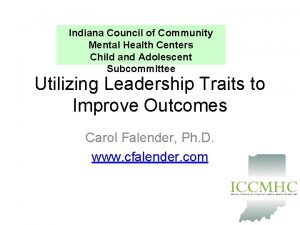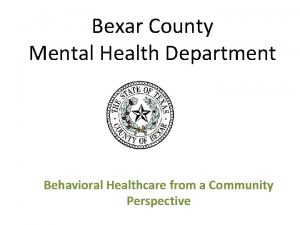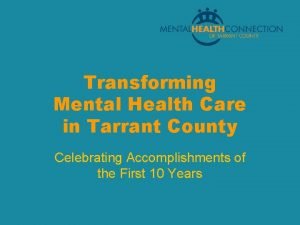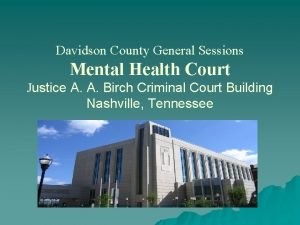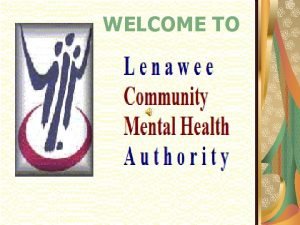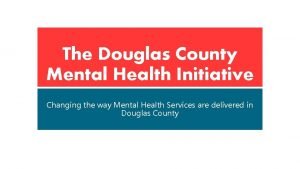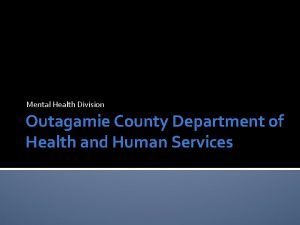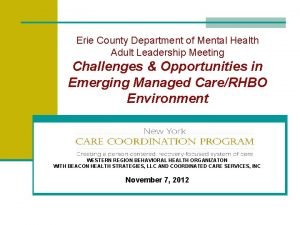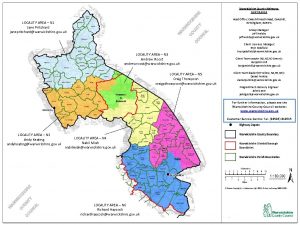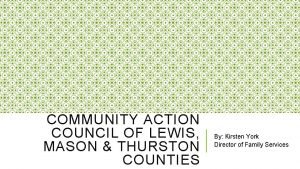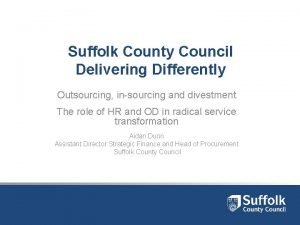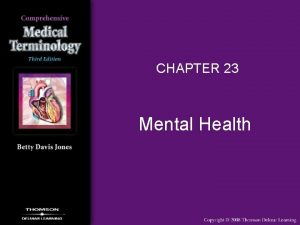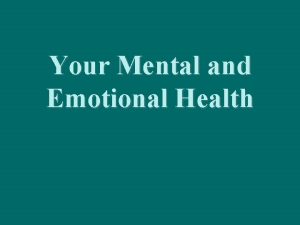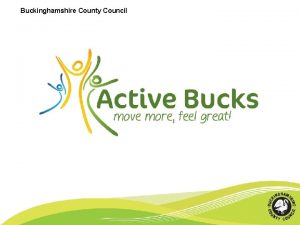The Kane County Mental Health Council A Laypersons



















- Slides: 19

The Kane County Mental Health Council A Layperson’s Guide to Mental Illness

Quote: “I have come a long way on my road to recovery over the past eleven years since hospitalization and have grown in selfdiscovery and awareness. ” - KATHY

MENTAL ILLNESS - Definition Mental Illness is a biological disorder of the brain that disrupts a person’s thinking, feeling, moods, and ability to relate to others. Just as diabetes is a disorder of the pancreas, mental illness is a brain disorder that often results in a diminished capacity for coping with the ordinary demands of life.

Mental Illness – Diagnoses (Affecting the U. S. population age >18 in a given year) n Attention Deficit/Hyperactivity Disorder (one of the most common mental disorders in children and adolescents, also affects about 4. 1 % of adults, ages 18 -44) n Bipolar Disorders (about 2. 6 % ) n Addictive Disorders n Major Depression (Leading cause of disability in the U. S. for ages 15 -44) n n n Eating Disorders Obsessive Compulsive Disorder(affects about 1. 0 % ) Panic Disorder(about 2. 7 % ) Post Traumatic Stress Disorder (about 3. 5%) Schizophrenia and Schizoaffective Disorders (About 1. 1% ) (Reference: Archives of General Psychiatry. 2005 Jun; 62(6): 593 -602. )

What is Mental Illness ? - Facts n Are biologically-based brain disorders. They cannot simply be “overcome” by will power. n Are not related to a person’s weakness, lack of character, intelligence or poor upbringing. n An estimated one in four adults suffer from a diagnosable mental disorder in a given year. About 1 in 17 suffer from a serious mental illness (Archives of General Psychiatry, 2005 Jun; 62(6): 617 -27) n Untreated mental illness can lead to disability, unemployment, substance abuse, homelessness and suicide. Untreated, the cost to the U. S. is more than $100 billion/year. n But, treatment works- between 70 and 90 percent of individuals can have significant reduction of symptoms and improved quality of life.

Mental Illness –Illinois Statistics n 2. 6 to 3. 9 million people or 20 -30% of the population n n will be affected by mental illness in any year. 260, 000 persons have either schizophrenia or bipolar affective disorder. 10% of the 3. 5 million children under the age of 19 have a serious emotional disturbance 90% of persons who commit suicide have a mental disorder 77% of adults with severe mental illnesses are unemployed (Reference: Illinois Mental Health Summit, U. I. C. 2007)

Mental Illness - Problem of Stigma. What does it lead to? n Labels lead to stigma; it exists…. and it hurts. n Estimates indicate that nearly two thirds of people with a n n n diagnosable mental illness do not seek treatment, especially people from diverse communities. Discourages a person’s/family’s willingness to admit to having a mental illness and seek treatment because of fear of rejection. Work, housing or school problems or discrimination. Delays members of the community from taking an interest in learning more about the illness and erodes confidence that mental illness is a real and treatable health condition. Inadequate health insurance coverage of mental illnesses. Has a negative influence for state funding of critical treatment and rehabilitation programs.

Mental Illness – Economic Impact (Ref: NAMI Policymaker's Fact Sheet on Mental Illness. No. 01 -02, 9/26/2002) n Direct costs, including hospitalizations and medications, to the Nation are estimated to be $70 billion annually. n Indirect costs to the Nation, including lost wages, family care-giving and lost productivity due to suicide, are estimated to be an additional $80 billion annually. n Approximately 53% of all mental health and substance abuse treatment costs are publicly funded, compared to 47% of total health care spending.

Mental Illness – Impact on Community n Individuals with an existing mental illness consume roughly 38 percent of all alcohol, 44 percent of all cocaine, and 40 percent of all cigarettes in the United States. (To Improve Health and Health Care Vol XI The Robert Wood Johnson Foundation Anthology (J-B Public Health/Health Services Text). San Francisco: Jossey-Bass, 2007) n Diversion of Law Enforcement resources n Overcrowding of jails, shelters, nursing homes etc. (6, 000 persons with mental illnesses in state prisons; 15% of prison population) (Reference: Illinois Mental Health Summit, U. I. C. 2007)

Mental Illness – Treatment Works TREATMENT SUCCESS RATES n Panic Disorder: 80% n Bipolar Disorder: 80% n Major Depression: 85% n Schizophrenia: 60% (Ref: American Psychiatric Association 1993)

Mental Illness – Treatment Works SAVES MONEY n For every dollar spent on mental health services in Illinois, five dollars is saved in overall health care. (Ref: Mental Health Summit, University of Chicago, IL 8 -30 -2007) n For each dollar invested in treatment, studies have found a four to seven dollar cost-savings on crime and criminal justice costs. The cost of incarcerating someone for five years is $125, 000 – a cost that is much higher than treatment (ONDP, 1999)

Mental Illness – Treatment Works RECOVERYn “Recovery is a journey of healing and transformation enabling a person with a mental health problem to live a meaningful life in a community of his or her choice while striving to achieve his or her full potential. ” (National Consensus Statement on Mental Health Recovery) n Early identification and treatment is of vital importance; By ensuring access to the treatment and recovery supports that are proven effective, recovery is accelerated and the further harm related to the course of illness is minimized.

Quote: “I believe strongly with the view that Recovery can occur even though symptoms of mental illness may reoccur. ” - CORINNE

Mental Illness - Actions DE-STIGMATIZE MENTAL ILLNESS n Work to replace denial, fears and misunderstandings with knowledge, understanding and hope. n Recognize that mental disorders are definable, diagnosable, and treatable. n Avoid words and phrases that are stigmatizing and dehumanizing, such as “wacko”, “bonkers”, and “sicko”.

Mental Illness - Actions COMMUNITY EDUCATION n Promote “Treatment Works” n Educate families through NAMI’s Family-to-Family education program. n The public and our legislators need to understand how critical the demand is for expansion of mental health services. n Media coverage of the successes of treatment, not just the sensational episodes of people with a mental illness who are not in treatment.

Mental Illness – Actions ADVOCACY n Can involve listening and giving information; n Encouraging the client to speak on their own behalf ; n Liaison with different agencies; n Mediating so people understand each other; n Representing or acting on behalf of someone. n n n http: //www. treatmentadvocacycenter. org/ http: //www. nami. org/ http: //www. nmha. org/ http: //www. bazelon. org/links/nat_advocates. htm http: //www. narpa. org/webdoc 6. htm

Mental Illness - Education IMPORTANT: n Each of us has an opportunity to make a difference in the workplace and in the community by becoming better informed about the facts that are now known about the causes, symptoms and treatment of mental illness.

Quote: “I have gone beyond our four walls, and I am dedicated to educating the public about what mental illness really is. ” - GUY

Mental Illness - Resources n Employees Assistance Programs (EAP) Human Resources n National Mental Health Information Center www. samhsa. gov n Mental Health America http: //www. mentalhealthamerica. net n Kane County Mental Health Council http: //www. kanecountymentalhealth. org n National Alliance On Mental Illness http: //www. nami. org
 Indiana council of community mental health centers
Indiana council of community mental health centers Kane county recycle
Kane county recycle Chapter 20 mental health and mental illness
Chapter 20 mental health and mental illness Mental health jeopardy questions
Mental health jeopardy questions Mental health america of san diego county
Mental health america of san diego county Bexar county mental health services
Bexar county mental health services Mental health connection of tarrant county
Mental health connection of tarrant county King county mental health court
King county mental health court Davidson county mental health court
Davidson county mental health court Lenawee county community mental health
Lenawee county community mental health Douglas county mental health initiative
Douglas county mental health initiative Outagamie county mental health
Outagamie county mental health Erie county department of mental health
Erie county department of mental health Lancashire county council planning
Lancashire county council planning County highways warwickshire
County highways warwickshire Arts council of hillsborough county
Arts council of hillsborough county Grat trust
Grat trust Community action council thurston county
Community action council thurston county Lincolnshire county council corporate plan
Lincolnshire county council corporate plan Hr outsourcing suffolk
Hr outsourcing suffolk
